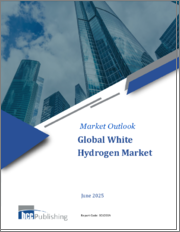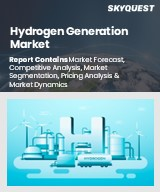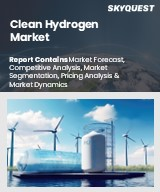
|
시장보고서
상품코드
1535655
전해 액체 수소 시장 규모 : 공급별, 최종 용도별, 지역별 전망과 예측(2024-2032년)Electrolysis Liquid Hydrogen Market Size - By Distribution (Pipelines, Cryogenic Tanks), By End use (Transportation, Chemicals and Others), Regional Outlook & Forecast, 2024 - 2032 |
||||||
전해 액체 수소 시장은 2024-2032년 7.2%의 CAGR을 나타낼 것으로 생각됩니다.
화석연료 사용으로 인한 환경 영향에 대응하고자 하는 열망에 힘입어 청정 에너지에 대한 수요가 증가하고 있기 때문입니다. 전기분해는 지속가능한 무공해 방식이며, 특히 풍력, 태양광, 수력 등 재생 에너지로 구동되는 경우 특히 적합합니다. 수소는 운송, 발전, 산업 공정 등 다양한 분야에 걸친 청정 연료로서 다용도하고 온실가스 배출을 억제할 수 있으므로 탈탄소화라는 세계 의제에 부합합니다. 국제에너지기구(IEA)에 따르면 2022년 세계 수소 수요는 9,000만 톤에 달할 것으로 예상되며, 이는 2021년 대비 3% 증가한 수치입니다.
또한 전기분해 기술의 발전이 눈부시게 발전하여 효율을 높이고 운영비용을 절감할 수 있습니다. 예를 들어 수소위원회(Hydrogen Council)의 보고서에 따르면 지난 10년간 전기분해를 통한 수소 생산 비용은 40% 가까이 감소했습니다. 이러한 기술적 진보를 보완하는 것은 수소를 매우 중요한 대체 에너지원으로 자리매김하기 위한 세계 각국의 정부 정책과 인센티브입니다. 각국은 수소 인프라 및 연구개발에 대한 투자를 확대하며 수소 경제의 기반을 다지고 있습니다. 이 모든 요인들이 시장 평가에 박차를 가할 것으로 보입니다.
파이프라인 부문은 생산 현장에서 최종사용자까지 수소를 효율적이고 비용 효율적으로 운송할 수 있으므로 2032년까지 상당한 성장을 기록할 것으로 예상됩니다. 파이프라인은 대규모의 지속적인 공급을 위한 신뢰할 수 있는 인프라를 제공하며, 다른 운송 방식에서 발생하는 손실과 비용을 최소화합니다. 이 인프라는 정유공장, 화학공장, 연료전지 차량용 충전소 등 대량의 안정적인 수소 공급이 필요한 산업에서 특히 중요합니다. 또한 수소 전용 파이프라인의 개발 및 기존 천연가스 파이프라인의 수소화 작업은 그린 수소의 에너지 그리드 통합을 촉진하고, 수소를 주류 에너지원으로 채택하는 것을 가속화할 것입니다.
2032년까지 시장 수요를 주도할 분야는 화학 분야입니다. 수소는 비료용 암모니아, 메탄올 및 기타 필수 화학 물질을 생산하기 위한 기본 원료입니다. 산업계가 보다 지속가능한 관행으로 전환을 모색함에 따라 전기분해로 생산되는 친환경 수소의 채택이 점점 더 매력적으로 다가오고 있습니다. 이러한 변화는 탄소 배출량을 줄이고 엄격한 환경 규제를 준수하고자 하는 열망에 의해 추진되고 있습니다. 화학 부문에서 친환경 대체품으로의 전환은 전해 액체 수소에 대한 수요를 크게 증가시킬 것으로 예상됩니다.
유럽의 전해 액체 수소 시장 규모는 엄격한 환경 규제, 막대한 정부 자금 지원, 탄탄한 재생에너지 인프라의 조합에 힘입어 2032년까지 빠른 속도로 성장할 것으로 예상됩니다. 유럽연합(EU)의 그린딜과 수소 전략은 이러한 약속을 더욱 강조하며, 수소 프로젝트에 막대한 재정적 인센티브와 규제적 지원을 제공합니다. 또한 유럽의 첨단 재생에너지 분야, 특히 풍력 및 태양광발전은 효율적인 전기분해 공정에 필요한 청정 전력을 공급할 수 있습니다. 민관 협력과 수소 인프라에 대한 투자는 이 지역 시장 성장을 가속하고 있습니다.
목차
제1장 조사 방법과 조사 범위
제2장 개요
제3장 업계 인사이트
- 업계 에코시스템
- 규제 상황
- 업계에 대한 영향요인
- 촉진요인
- 업계의 잠재적 리스크 & 과제
- 성장 가능성 분석
- Porter의 산업 분석
- PESTEL 분석
제4장 경쟁 구도
- 서론
- 전략 대시보드
- 혁신과 테크놀러지 전망
제5장 시장 규모·예측 : 공급별, 2021-2032년
- 주요 동향
- 파이프라인
- 저온 탱크
제6장 시장 규모·예측 : 최종 용도별, 2021-2032년
- 주요 동향
- 운송
- 화학
- 기타
제7장 시장 규모·예측 : 지역별, 2021-2032년
- 주요 동향
- 북미
- 미국
- 캐나다
- 유럽
- 독일
- 영국
- 프랑스
- 이탈리아
- 아시아태평양
- 중국
- 인도
- 일본
- 한국
- 호주
- 세계의 기타 지역
제8장 기업 개요
- Air Liquide
- Air Products and Chemicals, Inc.
- Cummins Inc
- ENGIE
- ITM Power
- Linde Plc
- MAN Energy Solutions
- NEL Hydrogen
- Plug Power Inc
- Shell plc
- Thyssenkrupp
The Electrolysis Liquid Hydrogen Market will exhibit 7.2% CAGR during 2024 to 2032, propelled by the escalating demand for clean energy, driven by a desire to counter the environmental repercussions of fossil fuel usage. Electrolysis is a sustainable, zero-emission method, especially when powered by renewable sources like wind, solar, or hydropower. This aligns with the worldwide agenda for decarbonization, given hydrogen's versatility as a clean fuel across sectors such as transportation, power generation, and industrial processes, thereby curbing GHG emissions. According to the International Energy Agency (IEA), global hydrogen demand reached 90 million metric tons in 2022, a surge of 3% as compared to 2021.
Furthermore, there are notable advancements in electrolysis technology, leading to enhanced efficiency and reduced operational costs. For instance, the cost of producing hydrogen via electrolysis has decreased by nearly 40% over the past decade, according to a report by the Hydrogen Council. Complementing these technological strides are government policies and incentives worldwide, aimed at positioning hydrogen as a pivotal alternative energy source. Nations are channeling investments into hydrogen infrastructure and R&D, laying the groundwork for a robust hydrogen economy. All these factors will add to the market valuation.
The overall electrolysis liquid hydrogen industry is classified based on distribution, end use, and region.
The pipelines segment is poised to record decent growth through 2032, owing to efficient and cost-effective transportation of hydrogen from production sites to end-users. Pipelines offer a reliable infrastructure for large-scale and continuous supply, minimizing the losses and costs associated with other transportation methods. This infrastructure is particularly crucial for industries that require a steady and substantial hydrogen supply, such as refineries, chemical plants, and fuel cell vehicle refueling stations. Furthermore, the development of dedicated hydrogen pipelines or the adaptation of existing natural gas pipelines to handle hydrogen facilitate the integration of green hydrogen into the energy grid, thereby accelerating the adoption of hydrogen as a mainstream energy source.
The chemicals segment is set to drive the market demand by 2032. Hydrogen is a fundamental feedstock in producing ammonia for fertilizers, methanol, and other essential chemicals. As industries seek to transition towards more sustainable practices, the adoption of green hydrogen produced through electrolysis becomes increasingly attractive. This shift is driven by the desire to reduce carbon footprints and comply with stringent environmental regulations. The chemicals sector's move towards greener alternatives will significantly boost the demand for electrolysis liquid hydrogen.
Europe electrolysis liquid hydrogen market size will expand at a notable pace through 2032, propelled by a combination of stringent environmental regulations, substantial government funding, and robust renewable energy infrastructure. The European Union's Green Deal and Hydrogen Strategy further underscore this commitment, providing significant financial incentives and regulatory support for hydrogen projects. Additionally, Europe's advanced renewable energy sector, particularly in wind and solar power, provides the necessary clean electricity for efficient electrolysis processes. Collaboration between public and private sectors, along with investments in hydrogen infrastructure are pushing the regional market growth.
Table of Contents
Chapter 1 Methodology & Scope
- 1.1 Research Design
- 1.2 Base estimates & calculations
- 1.3 Forecast model
- 1.4 Primary research & validation
- 1.4.1 Primary sources
- 1.4.2 Data mining sources
- 1.5 Market Definitions
Chapter 2 Executive Summary
- 2.1 Industry 360° synopsis, 2021 - 2032
Chapter 3 Industry Insights
- 3.1 Industry ecosystem
- 3.2 Regulatory landscape
- 3.3 Industry impact forces
- 3.3.1 Growth drivers
- 3.3.2 Industry pitfalls & challenges
- 3.4 Growth potential analysis
- 3.5 Porter's analysis
- 3.5.1 Bargaining power of suppliers
- 3.5.2 Bargaining power of buyers
- 3.5.3 Threat of new entrants
- 3.5.4 Threat of substitutes
- 3.6 PESTEL analysis
Chapter 4 Competitive landscape, 2023
- 4.1 Introduction
- 4.2 Strategic dashboard
- 4.3 Innovation & technology landscape
Chapter 5 Market Size and Forecast, By Distribution, 2021 - 2032 (USD Billion & MT)
- 5.1 Key trends
- 5.2 Pipelines
- 5.3 Cryogenic tanks
Chapter 6 Market Size and Forecast, By End Use, 2021 - 2032 (USD Billion & MT)
- 6.1 Key trends
- 6.2 Transportation
- 6.3 Chemicals
- 6.4 Others
Chapter 7 Market Size and Forecast, By Region, 2021 - 2032 (USD Billion & MT)
- 7.1 Key trends
- 7.2 North America
- 7.2.1 U.S.
- 7.2.2 Canada
- 7.3 Europe
- 7.3.1 Germany
- 7.3.2 UK
- 7.3.3 France
- 7.3.4 Italy
- 7.4 Asia Pacific
- 7.4.1 China
- 7.4.2 India
- 7.4.3 Japan
- 7.4.4 South Korea
- 7.4.5 Australia
- 7.5 Rest of World
Chapter 8 Company Profiles
- 8.1 Air Liquide
- 8.2 Air Products and Chemicals, Inc.
- 8.3 Cummins Inc
- 8.4 ENGIE
- 8.5 ITM Power
- 8.6 Linde Plc
- 8.7 MAN Energy Solutions
- 8.8 NEL Hydrogen
- 8.9 Plug Power Inc
- 8.10 Shell plc
- 8.11 Thyssenkrupp



















